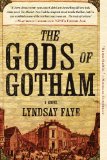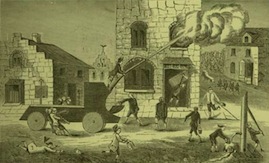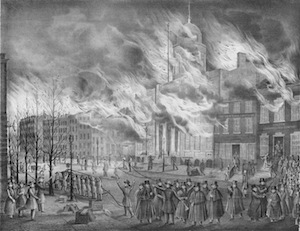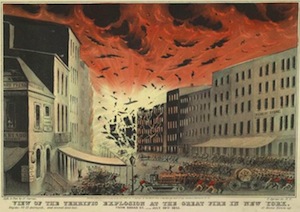Summary | Excerpt | Reading Guide | Reviews | Beyond the Book | Read-Alikes | Genres & Themes | Author Bio

A Novel
by Lyndsay FayeThis article relates to The Gods of Gotham
In Lyndsay Faye's novel, The Gods of Gotham, a fire ravages lower Manhattan, setting the stage for her suspenseful historical mystery. In reality, New York City has fallen victim to more than one devastating blaze.
In 1609, Henry Hudson, a British explorer hired by the Dutch to find a faster route to "the Orient," followed what is now called the Hudson River as far as Albany. After realizing that the river would not go through to the Pacific Ocean, Hudson returned to the nearby bay and set up a camp, establishing the Dutch Republic claim to the area. It became a fur trading settlement by 1624, officially becoming the colony of New Amsterdam in 1626 when colonial Director-General Peter Minuit purchased Manhattan from a small band of Lenape natives for 60 guilders (about $1,000). (The legend that it was purchased for $24 worth of glass beads has since been debunked.)
By 1664, the British took control of the land and King Charles II's brother, the Duke of York, renamed it "New York." The area grew in importance as a trading post, specifically in the selling of African and Caribbean slaves. By 1775, the American Revolution had begun, and New York patriots seized City Hall. The following year, George Washington and his troops fought to keep the city and its precious harbor.
According to CUNY's Virtual New York website, during the summer of 1776, a great fire erupted in New York:
George Washington and other officers in the Revolutionary army had decided that the city would be difficult to defend against the overwhelming British force. Some of Washington's advisors suggested burning New York City so that the British would gain little from its capture. This idea was abandoned and Washington withdrew his forces from the city on September 12, 1776. Three days later the British occupied the city and on September 21, a fire broke out in the Fighting Cocks Tavern. Without the city's firemen present and on duty, the fire quickly spread. A third of the city burnt and 493 houses destroyed... Washington mused that some honest patriot might have helped them out by setting the fire. The British were also convinced that the fire had been deliberately set. They arrested 200 suspected sympathizers and hung the self-described American spy, Nathan Hale... The British made little attempt to rebuild the city but did create their own fire department, realizing that fire was as much their enemy as the colonial rebels were.

After seven more years of fighting in the Revolutionary War, Washington and his troops reclaimed New York in 1783. In the years that followed, the area was transformed by several major developments. First, the Erie Canal was completed in 1825, running 363 miles between Albany and Buffalo, New York. This opened the interior of the agricultural US to trade and made New York one of the busiest port cities in the world. Also, in the 1830s, New York became a center of abolitionist activism.
As trade expanded and New York's economic importance increased, fire once again became a major threat. According to CUNY's Virtual New York website:
Insurance companies worried that a large fire could sap their resources; influential politicians and citizens feared the potentially disastrous impact of fire on the city's prospects for continued growth... While city officials were personally and materially invested in protecting the city from fire and made efforts to build more watch towers and hire more watchmen, one serious impediment to fire fighting was becoming apparent: the lack of a reliable water source for the city... In addition to an inadequate water supply, the fire department's growth in the 1820s and 1830s had not kept pace with the growth of the city.

By December 1835, the city's population had increased by approximately 145,000 people, however the fire department had only gained 300 more men. On December 14, "the entire fire department - 1,500 strong - had spent the freezing, miserable evening fighting two large fires, which destroyed thirteen buildings and two shops. The city's fire cisterns were nearly empty and its fire fighting force exhausted when disaster struck." On December 16, the majority of lower Manhattan went up in smoke when a blaze started at a five-story warehouse. Temperatures were so low that water froze in the hoses, making it difficult to extinguish the flames.
The Great Fire of 1835 destroyed nearly 700 buildings. The area from Bond Street to South Street and from Wall Street to Coenties Slip (as it was called then) was in ashes. Most of the destroyed buildings were commercial enterprises, including shops, warehouses, businesses and the like. Thousands of New Yorkers were out of work. Surprisingly, there were only two casualties from amongst the slew of people - ranging from firefighters to observers and looters - present at the fire. In contrast, four hundred people would eventually be arrested for looting during the fire. The damage was estimated at $20 million. All but three of the city's twenty-six fire insurance companies went bankrupt.

In 1845, just as New York began recovering from the disaster of 1835, another fire - in almost the exact same location - set the city ablaze. (This is the fire that sets the stage for Faye's Gods of Gotham.) According to The Bowery Boys: NYC History website:
Some distinct circumstances set it apart from the prior, more destructive blaze. It occurred before the crack of dawn on Saturday, July 19, 1845, on the third floor of an "oil store" on New Street - only a couple blocks from where the Great Fire of 1835 had started... Unfortunately, a warehouse owned by the merchants Crocker & Warren, just a block away at 38 Broad Street, was filled with a new shipment of saltpetre [potassium nitrate], used for the manufacture of gunpowder. Fire wafted in through an opening in one of the store's open iron shutters, and the result was a series of cannon-like bursts of smoke and fire, almost like a volcano, smashing into buildings across the street. It culminated in a terrible, final explosion, completely engulfing the block. The explosion was heard as far away as Sandy Hook, New Jersey.
The fire, which destroyed an estimated 300-350 buildings, cost the city between 6 and 10 million dollars to repair.
Images from top to bottom, the Great Fires of 1776, 1835, and 1845, respectively
Filed under People, Eras & Events
![]() This "beyond the book article" relates to The Gods of Gotham. It originally ran in April 2012 and has been updated for the
March 2013 paperback edition.
Go to magazine.
This "beyond the book article" relates to The Gods of Gotham. It originally ran in April 2012 and has been updated for the
March 2013 paperback edition.
Go to magazine.
The only real blind person at Christmas-time is he who has not Christmas in his heart.
Click Here to find out who said this, as well as discovering other famous literary quotes!
Your guide toexceptional books
BookBrowse seeks out and recommends the best in contemporary fiction and nonfiction—books that not only engage and entertain but also deepen our understanding of ourselves and the world around us.